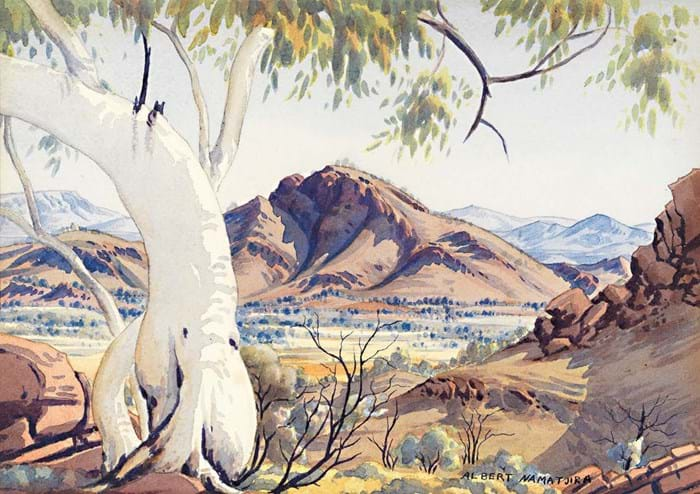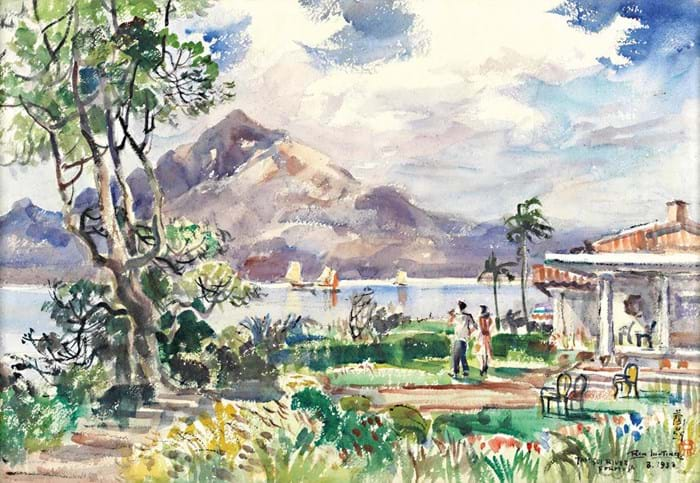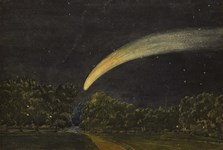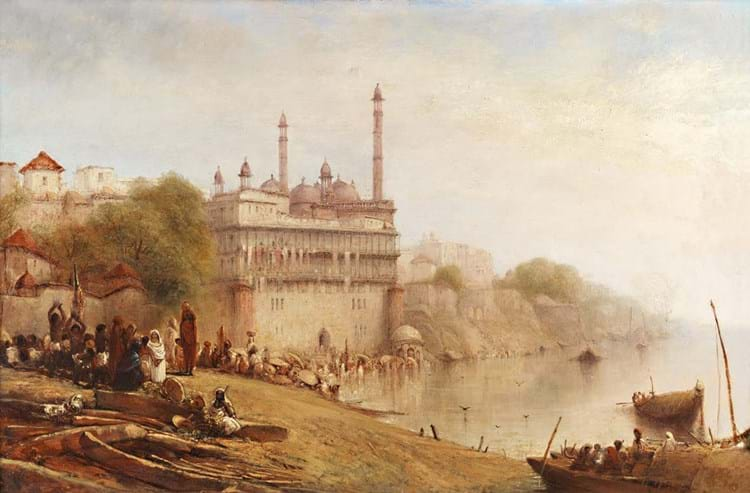
Has the boat already sailed for travel and exploration pictures? The once buoyant market has had its ups and downs over the years but it is a matter of some debate whether the sector is now past its heyday or if its best days lie ahead.
In a less-than bullish sign, Christie’s confirmed at the end of last year that it was ending its stand-alone topographical auctions in London after 52 years and incorporating the specialist department into the 19th century picture department (see News, ATG no 2467).
Furthermore, Sotheby’s last held one of its The Art of Travel sales in December 2019 and it is unclear if and when these will re-emerge.
While both still offer separate sales in related categories such as Orientalist, Indian and South East Asian art, Bonhams (27.5/25/20/14.5% buyer’s premium) has kept dedicated travel and exploration auctions.
The auction house clearly believes some mileage remains and its latest specialist event took place on February 10. And in a move perhaps targeted to catch a few consignments from the big two, Bonhams is now upping the number of sales in this category from one to two per year, the next being on September 14.
The most recent offered 191 lots: a typical mixture of pictures, books, journals, photographs, maps and a few objects. It performed better than some might have expected with 84% of the lots sold for a premium-inclusive £880,000 total. By value, 87% of the lots found buyers.
Pictures made up over the half of the lots and contributed a hefty chunk of the overall total.
Online accessibility
The specialist in charge of the sale Leo Webster said: “The results of the sale were very healthy across the board and we can definitely attribute some of that to the accessibility that online has granted.
“What we are seeing is increased interest across the sector, whether it be for prints, photographs, paintings, or watercolours – professional or amateur.”
In particular he pointed to the strong performance of the 23 works with Indian subjects, all of which sold for a combined £94,000 with a large proportion comfortably outstripping their estimates.
“Where previously the market was driven by British and European collectors, we are now finding a much larger number of Indian buyers entering the market,” said Webster.
“This is probably the key reason for the increase in prices achieved. The reason for this extra engagement with buyers in India is likely due to the accessibility offered by online bidding platforms – it has become a lot easier for these buyers to bid with us.”
Mosque view
One of the sale highlights was an intriguing view of the mosque of Aurangzeb in Uttar Pradesh by the little-known British artist Richard Robert Drabble (fl.1859-85). Few details are known about him other than he exhibited at the Royal Academy several times from 1859-85, each work being a landscape.
The picture here was believed to date from the early 1860s – an old label on the stretcher gave the artist’s address in Notting Hill where he lived during this period.
No reference exists that he ever left the UK but, although it cannot be said for certain that Drabble ever travelled to India himself, Webster felt the 2ft x 3ft (61 x 92cm) signed oil on canvas gave the impression of somebody who had experienced the hustle-and-bustle and atmosphere of life by the Ganges.
It had a what appeared to be an authentic hazy quality as well as some well-observed architectural elements, but the rare subject matter lifted this work in to an altogether different commercial category than simply a work by an obscure artist with seemingly no track record at auction.
The mosque in Varanasi (also known as Benares) was built in 1669 by the Mughal Emperor Aurangzeb, who named it the ‘Alamagir Mosque’ after his own honorific title. It was built on the site of one of the most sacred temples and stands near to the Gyan Vapi (Wisdom Well) where it was said the god Shiva had cooled his fiery lingam.
Estimated at £6000-8000, the combination of the location depicted and topographical appeal sparked strong competition before it sold at £20,000 to a US dealer on thesaleroom.com. The price not only ‘introduced’ Drabble at a high level on the secondary market but also showed the “renewed vitality” in the market for Indian subjects, according to Webster.
Among the other works in the Indian section drawing strong bidding was a group of hand-coloured engravings by Captain Robert Melville Grindlay (1786-1877), a self-taught amateur artist who served with the East India Company’s military service.
Depicting scenes from the western regions of India, the lot exceeded a £2000-4000 estimate and sold for £7000.
Modern collaboration
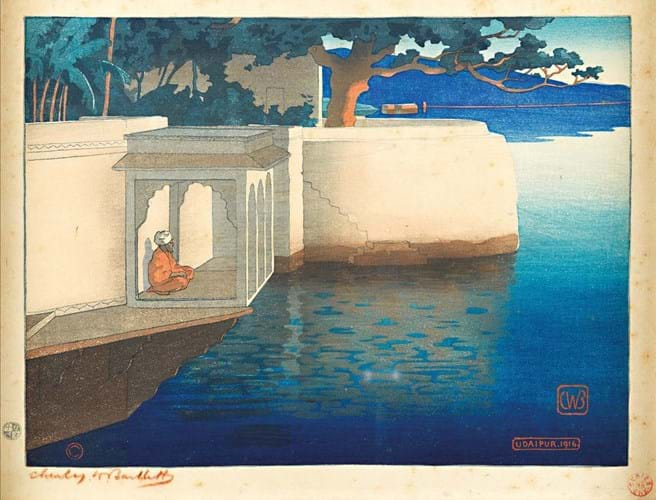
'Udaipur, 1916', one of seven woodblock prints by Charles William Bartlett that sold together for £7000 at Bonhams.
Another selection of prints catching the eye were a group of seven woodblock prints by Charles William Bartlett (1860-1940) which also included attractive subjects such as the Taj Mahal at sunset and the Golden Temple at Amritsar.
The works were produced after the artist met the Japanese publisher Watanabe Shozaburo while living in Tokyo. The latter adapted Bartlett’s vivid sketches and watercolours into a series of prints with simple designs and flat areas of rich colour – a collaboration of modern and traditional techniques which produced some striking results.
Most individual examples of these prints that have emerged before have sold for prices in the hundreds of pounds, but here the £1500-2000 estimate was easily surpassed and the lot went for £7000.
Although the artist’s views of Hawaii can certainly make more, the average price per print here (£1000) appears to be one of the highest for Indian subjects by the artist.
In the outback
Outside of the Indian works, a good bidding battle came for a vintage landscape of the Australian outback by Albert Namatjira (1902-59).
A ghost gum on Washwood Stn. (Mt. Bowman) was an 11 x 15½in (28 x 39cm) signed watercolour depicting a view near Haasts Bluff in central Australia. According to the catalogue, works by the Aboriginal painter are said to function as “maps of his sacred ancestral land for which he was custodian”.
As with some of his other works, this one demonstrated his interest in photography with the use of the ghost gum tree to crop the scene and focus the viewer’s gaze. It came to auction from a UK collection and was well received against its £8000-12,000 pitch. After a decent battle, it sold for £16,000 to a private UK buyer – a sum in keeping with previous auction results for these distinctive works.
South-East Asian interest
Among a decent number of lots selling to south-east Asian buyers was a busy market scene by Indonesian artist Anak Agung Gede Sobrat (1911-92), a painter best known for his views of village life and Balinese dances. It came to auction from a Danish vendor and was estimated at £6000-8000 but took £11,000.
Selling to a different buyer was a watercolour of the Tamsui River in northern Taiwan by Ran In-Ting (1903-79) – an artist whose name is also spelt ‘Lan Yinding’.
Dating from 1958, it had good provenance having been acquired directly from the artist by the vendor’s father, a naval attaché in Formosa from 1956-59 who played an important diplomatic role liaising between the British government and the Chinese Nationalist Party’s leader General Chiang Kai-shek.
Indeed, the 15 x 22in (38 x 56cm) watercolour had been a gift from In-Ting who had depicted the vendor’s parents standing outside their house.
Works by the Taiwanese artist are an attractive commercial prospect in any case and this example, which was signed, inscribed and dated, proved to be exactly that as it exceeded a £3000-5000 estimate and was knocked down at £10,000 to a private south-east Asia buyer.
The fact that these sales command plenty of overseas interest is no doubt another reason behind Bonhams doubling its dedicated sales.
After Christie’s closed its department, you might call it a welcome boost for global Britain.


